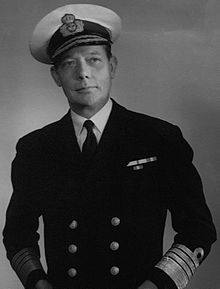Erhard J.C. Qvistgaard
- Machine translation, like DeepL or Google Translate, is a useful starting point for translations, but translators must revise errors as necessary and confirm that the translation is accurate, rather than simply copy-pasting machine-translated text into the English Wikipedia.
- Do not translate text that appears unreliable or low-quality. If possible, verify the text with references provided in the foreign-language article.
- You must provide copyright attribution in the edit summary accompanying your translation by providing an interlanguage link to the source of your translation. A model attribution edit summary is
Content in this edit is translated from the existing Danish Wikipedia article at [[:da:E.J.C. Qvistgaard]]; see its history for attribution. - You may also add the template
{{Translated|da|E.J.C. Qvistgaard}}to the talk page. - For more guidance, see Wikipedia:Translation.
Erhard J.C. Qvistgaard | |
|---|---|
 Qvistgaard in 1952 | |
| Chief of Defence | |
| In office 1 October 1950 – 30 September 1962 | |
| Preceded by | Office established |
| Succeeded by | Kurt Ramberg [da] |
| Chairman of the NATO Military Committee | |
| In office 1953–1954 | |
| Preceded by | Charles Foulkes |
| Succeeded by | Augustin Guillaume |
| Personal details | |
| Born | Erhard Jørgen Carl Qvistgaard (1898-05-11)May 11, 1898 Rorup, Denmark |
| Died | May 8, 1980(1980-05-08) (aged 81) Copenhagen, Denmark |
| Resting place | Gilleleje Cemetery |
| Later work | Board member of IBM Denmark |
| Military service | |
| Allegiance |  Denmark Denmark |
| Branch/service |  Royal Danish Navy Royal Danish Navy |
| Years of service | 1919–1962 |
| Rank | Admiral |
| Battles/wars | World War II |
Admiral Erhard Jørgen Carl Qvistgaard (1898–1980) was a Danish admiral who was the first Danish Chief of Defence, from 1950 to 1962, and also Chairman of the NATO Military Committee from 1953 to 1954.[1]
After training at the Naval Officers' School, Qvistgaard became a second lieutenant in 1919, a first lieutenant in 1920 and a lieutenant captain in 1928. In 1925-31 and again in 1935–38, he was commander of several of Denmark's submarines. In 1931-35 he was a teacher at the Naval Officers' School, and 1936-38 was a teacher at the submarine school for naval officers. In 1937 he became a naval captain, and from 1938 to 1945 he was an adjutant to King Christian X. In 1946, he was appointed Marine and Air Attaché at the Danish Embassy in London - a task he served in sufficiently[2] such that the then-Minister of Defense Hans Rasmus Hansen sent him on to the United States in 1949[3] with the temporary rank of Rear Admiral to act as a naval attaché and to lead the Danish delegation to the Washington group that was planning and setting up NATO.
Qvistgaard was given the job as the first Danish Chief of Defence in 1950. He was given the task of uniting the armed forces after the war, where there had been major friction between the three branches. He is the longest serving CoD to date.[4]
References
Literature
- Bjerg, Hans Christian. "Qvistgaard, Erhard Jørgen Carl". In Svend Cedergreen Bech (ed). Danish biographical lexicon. 3rd edition. Copenhagen: Schultz, 1979–84. Volume 11. [1] Archived 4 September 2017 at the Wayback Machine
- Lidegaard, Bo. In The King's Name: Henrik Kaufmann in Danish Diplomacy 1919-1958. Copenhagen: Samleren, 1996. ISBN 87-568-1377-5.
External links
- http://gravsted.dk/person.php?navn=ejcqvistgaard
| Military offices | ||
|---|---|---|
| Preceded by Charles Foulkes | Chairperson of the Nato Military Committee 1953–1954 | Succeeded by Augustin Guillaume |
| Preceded by None | Chief of Defence (Denmark) 1950–1962 | Succeeded by Kurt Rudolph Ramberg |
- v
- t
- e
- 1949–1951
 Omar Bradley
Omar Bradley - 1951–1952
 Etienne Baele
Etienne Baele - 1952–1953
 Charles Foulkes
Charles Foulkes - 1953–1954
 E. J. C. Quistgaard
E. J. C. Quistgaard - 1954–1955
 Augustin Guillaume
Augustin Guillaume - 1955–1956
 Stylianos Pallis
Stylianos Pallis - 1956–1957
 Giuseppe Mancinelli
Giuseppe Mancinelli - 1957–1958
 B. R. P. F. Hasselman
B. R. P. F. Hasselman - 1958–1959
 Bjarne Øen
Bjarne Øen - 1959–1960
 J. A. Beleza Ferraz
J. A. Beleza Ferraz - 1960–1960
 Rüştü Erdelhun
Rüştü Erdelhun - 1960–1961
 Louis Mountbatten
Louis Mountbatten - 1961–1962
 Lyman Lemnitzer
Lyman Lemnitzer - 1962–1963
 C. P. de Cumont
C. P. de Cumont - 1963–1964
 Adolf Heusinger
Adolf Heusinger - 1964–1968
 C. P. de Cumont
C. P. de Cumont - 1968–1971
 Nigel Henderson
Nigel Henderson - 1971–1974
 Johannes Steinhoff
Johannes Steinhoff - 1974–1977
 Peter Hill-Norton
Peter Hill-Norton - 1977–1980
 H. F. Zeiner-Gundersen
H. F. Zeiner-Gundersen - 1980–1983
 Robert Hilborn Falls
Robert Hilborn Falls - 1983–1986
 Cornelis de Jager
Cornelis de Jager - 1986–1989
 Wolfgang Altenburg
Wolfgang Altenburg - 1989–1993
 Vigleik Eide
Vigleik Eide - 1993–1996
 Richard Vincent
Richard Vincent - 1996–1999
 Klaus Naumann
Klaus Naumann - 1999–2002
 Guido Venturoni
Guido Venturoni - 2002–2005
 Harald Kujat
Harald Kujat - 2005–2008
 Ray Henault
Ray Henault - 2008–2011
 Giampaolo Di Paola
Giampaolo Di Paola - 2011–2015
 Knud Bartels
Knud Bartels - 2015–2018
 Petr Pavel
Petr Pavel - 2018–2021
 Stuart Peach
Stuart Peach - 2021–2023
 Rob Bauer
Rob Bauer
 | This biographical article related to the military of Denmark is a stub. You can help Wikipedia by expanding it. |
- v
- t
- e

























 Erhard_J.C._Qvistgaard
Erhard_J.C._Qvistgaard